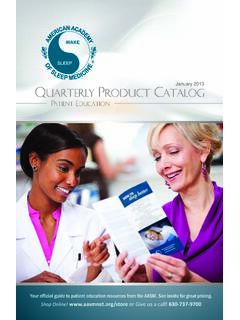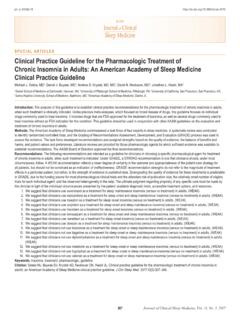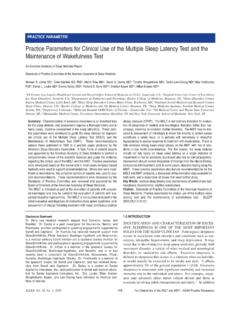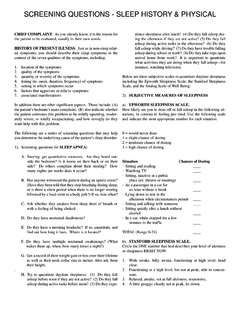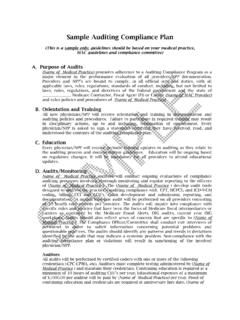Transcription of Standards for Accreditation - Sleep
1 Standards for AccreditationUpdated November 20162 The American Academy of Sleep Medicine (AASM) developed Standards for Accreditation with the primary purpose of ensuring that the highest quality of care is delivered to patients with Sleep disorders. The constant evolution of Sleep medicine necessitates an update to the AASM Standards for Accreditation to reflect the models of clinical practice that have emerged in recent years. New research, policy and technology are shifting the field toward comprehensive patient management. Accreditation of entities that offer diagnostic testing and comprehensive management for Sleep disorders is increasingly important as care focuses on improving population health and engaging patients while containing costs. As such, comprehensive Sleep facilities must have the capability to provide patient management and testing related to all Sleep disorders. Sleep facility is used specifically to refer to Sleep centers that comprise both a clinic, where patient evaluation and management occurs, and a laboratory, where diagnostic testing is administered through in-center Sleep studies and home Sleep apnea testing (HSAT).
2 The clinic and laboratory may be housed in separate locations. By meeting these Standards for Accreditation , Sleep facilities accredited by the AASM are accredited for all types of Sleep testing, including in-center polysomnography (PSG), Multiple Sleep Latency Testing (MSLT), Maintenance of Wakefulness Testing (MWT) and Quality Patient Care and Management All qualified Sleep medicine physicians and providers must be committed to providing quality patient care. Patients benefit greatly from direct personal interaction with the diagnosing/treating physician and other center staff providers. It is therefore the general position of the AASM that, in ideal circumstances, all patients evaluated and treated in an accredited Sleep facility should be seen by a board-certified Sleep physician or medical staff member prior to testing and the initiation of treatment. In appropriate instances, Sleep facilities also may use telemedicine tools in the provision of Sleep medicine services to expand interactions between Sleep physicians and Sleep , the AASM recognizes that patient consultations may be restricted by some health plans or prevented by a variety of other reasonable and unavoidable circumstances.
3 Every effort should be made to manage these conditions in the best interests of the patient and in a way that promotes high-quality care. It is the recommendation of the AASM that a Sleep facility should include in its policies a description of any circumstances that prevent patient consultations. Clinical Recommendations The AASM uses a rigorous, evidence-based process to establish practice guidelines on a variety of topics that are relevant to the practice of Sleep medicine. Accredited Sleep facilities must adopt and follow all STRONG and STANDARD level recommendation statements in all active AASM Clinical Practice Guideline, Practice Parameter and Clinical Guideline papers. In addition, it is recommended that accredited entities adopt and follow all other recommendation statements ( , Weak , Guideline, Option, and Consensus level recommendations) in all active AASM Clinical Practice Guideline, Practice Parameter and Clinical Guideline papers.
4 It is also recommended that accredited Sleep facilities follow applicable AASM Consensus and Position JudgmentThe AASM recognizes that the practice of Sleep medicine, like all other medical disciplines, is dynamic and complex, requiring clinical judgment. AASM Clinical Practice Guidelines, Practice Parameters and Clinical Guidelines are not designed to limit physicians from using their medical judgment. Therefore, unique 3circumstances may require deviation from AASM clinical recommendations for the appropriate evaluation and management of select patients. However, in such instances, the AASM accredited facility is expected to keep documentation on file that provides justification for the deviation in standard clinical practice. Compliance Facilities accredited by the AASM must be in compliance with all Accreditation Standards at the time of application and throughout the Accreditation period. If it is determined in the application review process that a facility is not in compliance with the required Standards , the application will be returned, and the facility will need to resubmit its application once the required Standards are met.
5 The AASM reserves the right to revoke Accreditation for facilities that are found to be non-compliant with the Standards for Accreditation during the period of Accreditation . Denial Denial of Accreditation will be recommended by the site visitor, reviewers, Accreditation committee, or staff when one or more of the following conditions are identified:1. The facility fails to meet any of the Accreditation Standards that are indicated as MANDATORY. Facilities will not be issued provisos for Accreditation Standards indicated as MANDATORY. (If granted Accreditation with provisos, the facility receives a letter that describes certain stipulations that must be met by a specified deadline to retain Accreditation .) 2. The facility is determined to be non-compliant with more than ten (10) non-mandatory Accreditation The facility fails to resolve provisos within the period of time allotted to correct the provisos. 4. The AASM has evidence that the facility submitted falsified documents or misrepresented information in seeking to achieve or retain The AASM is one of multiple bodies that offer Accreditation to entities that offer Sleep medicine services.
6 Accreditation by the AASM is a voluntary program offered to Sleep facilities that meet the Standards contained in this document. The AASM reserves the right to modify, add or remove Accreditation Standards at its own discretion and without notice. In addition, the AASM reserves the right to interpret the Standards for Accreditation as deemed appropriate. Facilities accredited by the AASM must comply with all applicable local, state and federal laws and regulations. If any law or government regulation conflicts with these Standards for Accreditation , the law or regulation supersedes the Accreditation standard. American Academy of Sleep Medicine 2510 North Frontage Road, Darien, IL 60561-1511 Voice | Facsimile | Email Academy of Sleep MedicineAASM SCORING MANUALThe AASM Manual for the Scoring of Sleep and Associated Events: Rules, Terminology and Technical SpecificationsABMSA merican Board of Medical SpecialtiesABSMA merican Board of Sleep MedicineACGMEA ccreditation Council for Graduate Medical EducationADAA mericans with Disabilities ActAEDA utomated External Defibrillator AHIA pnea-Hypopnea IndexAOAA merican Osteopathic AssociationAPRNA dvanced Practice Registered NurseA-STEPA ccredited Sleep Technologist education ProgramBRPTB oard of Registered Polysomnographic TechnologistsCAAHEPC ommission on Accreditation of Allied Health education ProgramsCECC ontinuing education CreditCMEC ontinuing Medical EducationCOARCC ommission on Accreditation for Respiratory CareCPRC ardiopulmonary ResuscitationCPSGTC ertified Polysomnographic TechnicianCRTC ertified Respiratory TherapistDMED urable Medical EquipmentHIPAAH ealth Insurance Portability and Accountability ActHITECHThe Health Information Technology for Economic and Clinical Health ActHSATHome Sleep Apnea TestICSDI
7 Nternational Classification of Sleep DisordersISRI nter-Scorer ReliabilityMSLTM ultiple Sleep Latency TestMWTM aintenance of Wakefulness TestNBRCN ational Board for Respiratory CareOSAO bstructive Sleep ApneaOSHA Occupational Safety and Health AdministrationPAPhysician AssistantPAPP ositive Airway PressurePHIP rotected Health InformationPSGP olysomnographyQAQuality AssuranceRDIR espiratory Disturbance IndexREIR espiratory Event Index5 RLSR estless Legs SyndromeRNRegistered NurseRPSGTR egistered Polysomnographic TechnologistRRTR egistered Respiratory TherapistRSTR egistered Sleep TechnologistAASM continuing education AppendixCME opportunities include: AASM Courses: Journal of Clinical Sleep Medicine: AASM Online Learning Opportunities: AASM MOC Modules: opportunities include: AASM ISR Record Review: AASM A-STEP: AAST Learning Opportunities: *AMA PRA Category 1 Credit or equivalent type of continuing education credit accepted/maintained by your profession will be StandardsA-1 Facility Director (MANDATORY)p.
8 8A-2 Licensing (MANDATORY)p. 8A-3 Medical Code of Conduct (MANDATORY)p. 8A-4 HIPAA Rules and Regulations (MANDATORY)p. 8 PersonnelB-1 Facility Director (MANDATORY)p. 9B-2 Facility Director Qualifications (MANDATORY)p. 9B-3 Facility Director Responsibilities p. 10B-4 Facility Director continuing education (MANDATORY)p. 10B-5 Medical Staff Member (MANDATORY)p. 10B-6 Medical Staff Member continuing education p. 10B-7 Sleep Technicians and Technologistsp. 11B-8 Registered Sleep Technologistp. 11B-9 Sleep Technician and Technologist continuing Educationp. 12B-10 Non-registered Sleep Technologistp. 12B-11 Scoring Personnelp. 12B-12 Addressing Problems during HSATp. 12B-13 Employee Background Checksp. 12 Patient PoliciesC-1 Patient Acceptance for In-center Testingp. 13C-2 Patient Acceptance for Home Sleep Apnea Testingp. 13C-3 Record Review of direct Referralsp. 13 Facility and EquipmentD-1 Permanent Addressp. 14D-2 Phone Linep. 14D-3 Signagep.
9 14D-4 Stationeryp. 14D-5 Use of Spacep. 14D-6 Testing Bedrooms Physical Characteristicsp. 14D-7 Testing Bedrooms & Emergency Carep. 14D-8 Bathroomsp. 14D-9 Handicap Testing Bedroom and Bathroomp. 15D-10 Control Roomp. 15D-11 Communicationp. 15D-12 Video Recordingp. 15D-13 Polysomnographic Equipmentp. 15D-14 Portable Recording Equipmentp. 15D-15 PAP Therapyp. 15 Accreditation Standards Table of Contents7 Policies and ProceduresE-1 Policy and Procedures Manualp. 16E-2 Protocols: PSG, HSAT, MSLT, MWT, and PAP Titrationp. 16E-3 Other Protocolsp. 16E-4 Pediatric Protocolsp. 16E-5 Equipment Maintenancep. 16E-6 HSAT Equipment Proceduresp. 17 Data Acquisition, Scoring and ReportingF-1 Signal Acquisitionp. 17F-2 PSG Reports p. 17F-3 HSAT Reports and Interpretationp. 17F-4 Conducting MSLT and MWTp. 17F-5 PSG Scoringp. 17F-6 Computer-assisted Scoringp. 17F-7 Inter-scorer Reliabilityp. 17F-8 Diagnosis of Sleep Disordersp. 18F-9 Subcontracting HSATp.
10 18F-10 Subcontracting Scoringp. 18 Patient Evaluation and CareG-1 Patient Management (MANDATORY)p. 18 Patient RecordsH-1 Medical Recordsp. 19H-2 PAP Assessmentp. 19H-3 Database/Storagep. 19 Emergency ProceduresI-1 Emergency Planp. 20I-2 HSAT Emergency Procedurep. 20I-3 Emergency Drillsp. 20I-4 Emergency Equipmentp. 20 Quality AssuranceJ-1 Facility Quality Assurance Programp. 20J-2 HSAT Quality Assurance Programp. 21J-3 Quality Improvementp. 21 SafetyK-1 Facility Safetyp. 21K-2 Occupational Safetyp. 21K-3 Hazardous Materialsp. 21K-4 Patient Safety Risk Analysisp. 21K-5 Patient Safety Related Significant Adverse Eventsp. 22K-6 Analysis of Significant Adverse Eventsp. 22K-7 Safety Risks Unique to In-center Sleep Testingp. 22 Patients RightsL-1 Patients Rightsp. 228A. General StandardsFacilities accredited by the AASM are considered qualified to perform all testing related to all Sleep disorders listed in the current version of the International Classification of Sleep Disorders.
